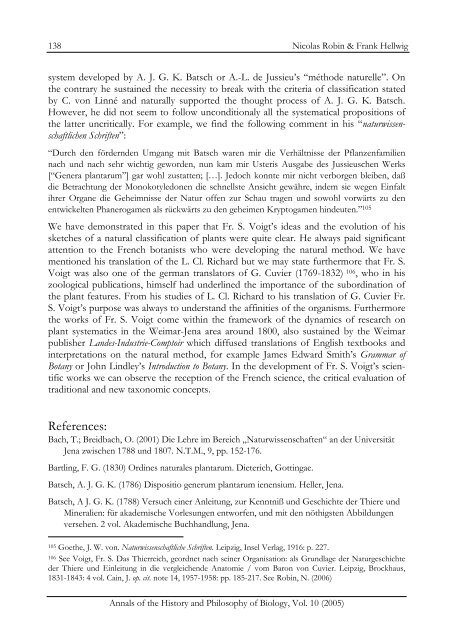Annals of the History and Philosophy of Biology
Annals of the History and Philosophy of Biology
Annals of the History and Philosophy of Biology
Create successful ePaper yourself
Turn your PDF publications into a flip-book with our unique Google optimized e-Paper software.
138<br />
<strong>Annals</strong> <strong>of</strong> <strong>the</strong> <strong>History</strong> <strong>and</strong> <strong>Philosophy</strong> <strong>of</strong> <strong>Biology</strong>, Vol. 10 (2005)<br />
Nicolas Robin & Frank Hellwig<br />
system developed by A. J. G. K. Batsch or A.-L. de Jussieu’s “méthode naturelle”. On<br />
<strong>the</strong> contrary he sustained <strong>the</strong> necessity to break with <strong>the</strong> criteria <strong>of</strong> classification stated<br />
by C. von Linné <strong>and</strong> naturally supported <strong>the</strong> thought process <strong>of</strong> A. J. G. K. Batsch.<br />
However, he did not seem to follow unconditionaly all <strong>the</strong> systematical propositions <strong>of</strong><br />
<strong>the</strong> latter uncritically. For example, we find <strong>the</strong> following comment in his “naturwissenschaftlichen<br />
Schriften”:<br />
“Durch den fördernden Umgang mit Batsch waren mir die Verhältnisse der Pflanzenfamilien<br />
nach und nach sehr wichtig geworden, nun kam mir Usteris Ausgabe des Jussieuschen Werks<br />
[“Genera plantarum”] gar wohl zustatten; […]. Jedoch konnte mir nicht verborgen bleiben, daß<br />
die Betrachtung der Monokotyledonen die schnellste Ansicht gewähre, indem sie wegen Einfalt<br />
ihrer Organe die Geheimnisse der Natur <strong>of</strong>fen zur Schau tragen und sowohl vorwärts zu den<br />
entwickelten Phanerogamen als rückwärts zu den geheimen Kryptogamen hindeuten.” 105<br />
We have demonstrated in this paper that Fr. S. Voigt’s ideas <strong>and</strong> <strong>the</strong> evolution <strong>of</strong> his<br />
sketches <strong>of</strong> a natural classification <strong>of</strong> plants were quite clear. He always paid significant<br />
attention to <strong>the</strong> French botanists who were developing <strong>the</strong> natural method. We have<br />
mentioned his translation <strong>of</strong> <strong>the</strong> L. Cl. Richard but we may state fur<strong>the</strong>rmore that Fr. S.<br />
Voigt was also one <strong>of</strong> <strong>the</strong> german translators <strong>of</strong> G. Cuvier (1769-1832) 106, who in his<br />
zoological publications, himself had underlined <strong>the</strong> importance <strong>of</strong> <strong>the</strong> subordination <strong>of</strong><br />
<strong>the</strong> plant features. From his studies <strong>of</strong> L. Cl. Richard to his translation <strong>of</strong> G. Cuvier Fr.<br />
S. Voigt’s purpose was always to underst<strong>and</strong> <strong>the</strong> affinities <strong>of</strong> <strong>the</strong> organisms. Fur<strong>the</strong>rmore<br />
<strong>the</strong> works <strong>of</strong> Fr. S. Voigt come within <strong>the</strong> framework <strong>of</strong> <strong>the</strong> dynamics <strong>of</strong> research on<br />
plant systematics in <strong>the</strong> Weimar-Jena area around 1800, also sustained by <strong>the</strong> Weimar<br />
publisher L<strong>and</strong>es-Industrie-Comptoir which diffused translations <strong>of</strong> English textbooks <strong>and</strong><br />
interpretations on <strong>the</strong> natural method, for example James Edward Smith’s Grammar <strong>of</strong><br />
Botany or John Lindley’s Introduction to Botany. In <strong>the</strong> development <strong>of</strong> Fr. S. Voigt’s scientific<br />
works we can observe <strong>the</strong> reception <strong>of</strong> <strong>the</strong> French science, <strong>the</strong> critical evaluation <strong>of</strong><br />
traditional <strong>and</strong> new taxonomic concepts.<br />
References:<br />
Bach, T.; Breidbach, O. (2001) Die Lehre im Bereich „Naturwissenschaften“ an der Universität<br />
Jena zwischen 1788 und 1807. N.T.M., 9, pp. 152-176.<br />
Bartling, F. G. (1830) Ordines naturales plantarum. Dieterich, Gottingae.<br />
Batsch, A. J. G. K. (1786) Dispositio generum plantarum ienensium. Heller, Jena.<br />
Batsch, A J. G. K. (1788) Versuch einer Anleitung, zur Kenntniß und Geschichte der Thiere und<br />
Mineralien: für akademische Vorlesungen entworfen, und mit den nöthigsten Abbildungen<br />
versehen. 2 vol. Akademische Buchh<strong>and</strong>lung, Jena.<br />
105 Goe<strong>the</strong>, J. W. von. Naturwissenschaftliche Schriften. Leipzig, Insel Verlag, 1916: p. 227.<br />
106 See Voigt, Fr. S. Das Thierreich, geordnet nach seiner Organisation: als Grundlage der Naturgeschichte<br />
der Thiere und Einleitung in die vergleichende Anatomie / vom Baron von Cuvier. Leipzig, Brockhaus,<br />
1831-1843: 4 vol. Cain, J. op. cit. note 14, 1957-1958: pp. 185-217. See Robin, N. (2006)

















